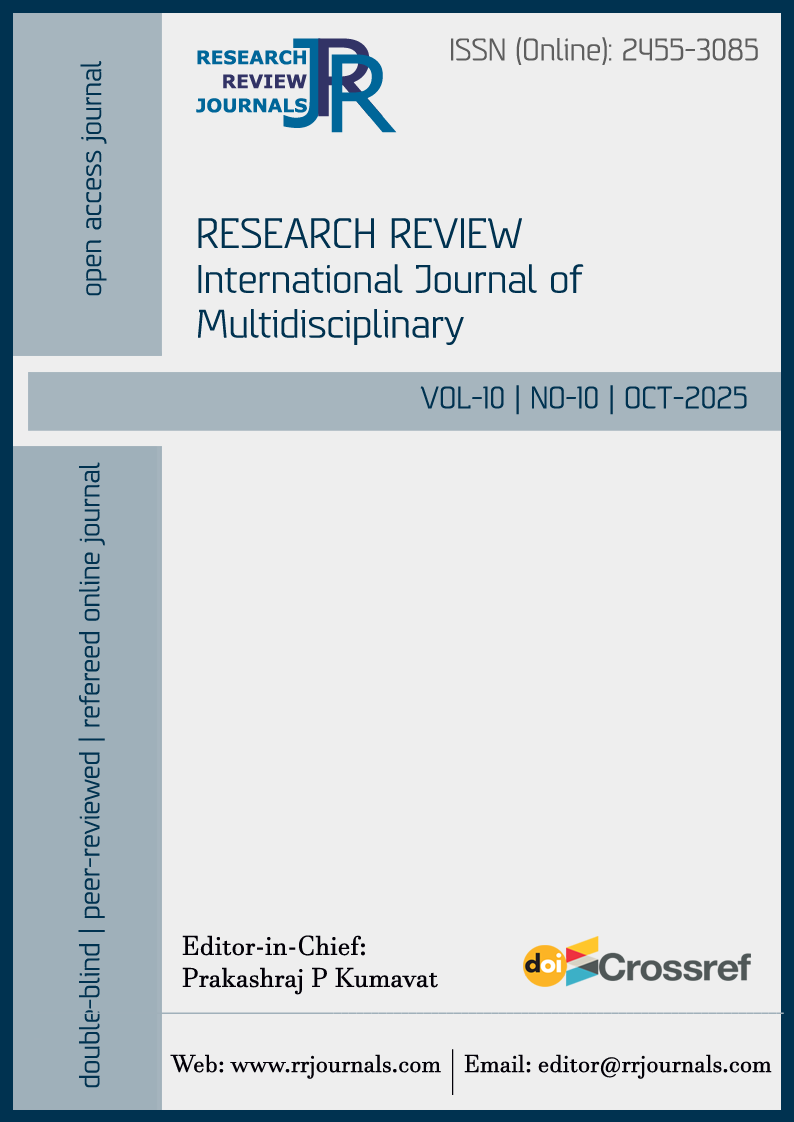Digital Persuasion or Digital Exploitation? Understanding the impacts of FOMO Marketing on Gen Z Consumer Behaviour
DOI:
https://doi.org/10.31305/rrijm.2025.v10.n10.010Keywords:
Brand trust, FOMO marketing, impulsive buying, perceived manipulation, post-purchase regret, psychological impactAbstract
Purpose: Digital marketing has led to the development of new strategies to influence consumer behaviour, and Fear of Missing Out (FOMO) marketing has become one of the primary target marketing campaigns aimed at Gen Z to generate urgency and anxiety, commonly leading to impulsive buying. This paper explores the psychological and behavioural effects of FOMO marketing on Gen Z consumers, which focuses on anxiety and urgency as mediators of impulsive purchases, perceived manipulation as a moderator of brand trust, and post-purchase regret as outcomes. Research design and methods: The survey of 300 Indian Gen Z users of social media was cross-sectional, and data were analysed using SPSS to conduct descriptive, correlational, regression, mediation, and moderation analysis of the data. Results: Results indicate that FOMO marketing has a high level of increasing anxiety and urgency, which partially mediates impulsive purchase, and perceived manipulation enhances the adverse effect of impulsive purchases on brand trust. Exposure to FOMO cues is also positively related to post-purchase regret. Research indicates that FOMO marketing is two-sided because, on the one hand, it may result in immediate sales, but on the other hand, it may have some psychological and ethical implications, causing losses in consumer trust and satisfaction in the long-term view. Implications: These findings can inform marketers with useful implications to create ethically transparent FOMO campaigns and theoretical advances by incorporating psychological mediators and perceptions of manipulation into FOMO studies.
References
Kurniawan, E. T., & Zuchroh, I. (2025). Influence of Influencer Marketing, Fear of Missing Out (FOMO), and Trust on Crypto Asset Purchase Decisions among Generation Z in Discord Miracle Class. Journal of Business Management and Economic Development, 3(03), 1033–1050. https://doi.org/10.59653/jbmed.v3i03.1932
Przybylski, A. K., Murayama, K., DeHaan, C. R., & Gladwell, V. (2013). Motivational, emotional, and behavioral correlates of fear of missing out. Computers in Human Behavior, 29(4), 1841–1848. https://doi.org/10.1016/j.chb.2013.02.014
Nguyen, D. N., & Van Nguyen, D. (2025). FOMO and the impulsive purchasing behavior of young people. European Journal of Business Management and Research, 10(3), 41–47. https://doi.org/10.24018/ejbmr.2025.10.3.2638
Bartosiak, A., Lee, J. E., & Loibl, C. (2025). Fear of missing out, social media influencers, and the social, psychological and financial wellbeing of young consumers. PLoS ONE, 20(4), e0319034. https://doi.org/10.1371/journal.pone.0319034
Voigt, C., Schlögl, S., & Groth, A. (2021). Dark Patterns in Online Shopping: of Sneaky Tricks, Perceived Annoyance and Respective Brand Trust. In Lecture notes in computer science (pp. 143–155). https://doi.org/10.1007/978-3-030-77750-0_10
Hodkinson, C. (2016). ‘Fear of Missing Out’ (FOMO) marketing appeals: A conceptual model. Journal of Marketing Communications, 25(1), 65–88. https://doi.org/10.1080/13527266.2016.1234504
Bright, L. F., & Logan, K. (2018). Is my fear of missing out (FOMO) causing fatigue? Advertising, social media fatigue, and the implications for consumers and brands. Internet Research, 28(5), 1213–1227. https://doi.org/10.1108/intr-03-2017-0112
Verplanken, B., & Herabadi, A. (2001). Individual differences in impulse buying tendency: feeling and no thinking. European Journal of Personality, 15(1_suppl), S71–S83. https://doi.org/10.1002/per.423
Tanveer, T., Kazmi, S. Q., & Rahman, M. U. (2022). Determinants of Impulsive Buying behavior: An empirical analysis of consumers’ purchase intentions for offline beauty products. NURTURE, 16(2), 75–89. https://doi.org/10.55951/nurture.v16i2.129
Sanny, L., Chandra, G. R., Chelles, K., & Santoso, L. A. (2023). The impulse buying of Gen Z when using E-Wallet in Indonesia. Journal of Applied Engineering and Technological Science (JAETS), 5(1), 88–100. https://doi.org/10.37385/jaets.v5i1.2600
Mathur, A., Acar, G., Friedman, M. J., Lucherini, E., Mayer, J., Chetty, M., & Narayanan, A. (2019). Dark patterns at scale. Proceedings of the ACM on Human-Computer Interaction, 3(CSCW), 1–32. https://doi.org/10.1145/3359183
Hamilton, R. W., Mittal, C., Shah, A., Thompson, D. V., & Griskevicius, V. (2018). How Financial constraints Influence Consumer Behavior: An Integrative framework. Journal of Consumer Psychology, 29(2), 285–305. https://doi.org/10.1002/jcpy.1074
Chaudhuri, A., & Holbrook, M. B. (2001). The Chain of Effects from Brand Trust and Brand Affect to Brand Performance: The Role of Brand Loyalty. Journal of Marketing, 65(2), 81–93. https://doi.org/10.1509/jmkg.65.2.81.18255
Zeelenberg, M., & Pieters, R. (2007). A Theory of Regret Regulation 1.0. Journal of Consumer Psychology, 17(1), 3–18. https://doi.org/10.1207/s15327663jcp1701_3
Hallikainen, H., Alamäki, A., & Laukkanen, T. (2018). Individual preferences of digital touchpoints: A latent class analysis. Journal of Retailing and Consumer Services, 50, 386–393. https://doi.org/10.1016/j.jretconser.2018.07.014
Creswell, J. W. (1994). Research Design: Qualitative, quantitative, and mixed methods approaches. http://www.revistacomunicacion.org/pdf/n3/resenas/research_design_qualitative_quantitative_and_mixed_methods_approaches.pdf
Etikan, I. (2016). Comparison of convenience sampling and purposive sampling. American Journal of Theoretical and Applied Statistics, 5(1), 1. https://doi.org/10.11648/j.ajtas.20160501.11
Hair, J. F., Hult, G. T. M., Ringle, C. M., Sarstedt, M., Danks, N. P., & Ray, S. (2021). Partial Least Squares Structural Equation Modeling (PLS-SEM) using R. In Classroom companion: business. https://doi.org/10.1007/978-3-030-80519-7
Miller, V. A., Reynolds, W. W., Ittenbach, R. F., Luce, M. F., Beauchamp, T. L., & Nelson, R. M. (2009). Challenges in measuring a new construct: perception of voluntariness for research and treatment decision making. Journal of Empirical Research on Human Research Ethics, 4(3), 21–31. https://doi.org/10.1525/jer.2009.4.3.21
Taber, K. S. (2017). The use of Cronbach’s Alpha when developing and reporting research instruments in science education. Research in Science Education, 48(6), 1273–1296. https://doi.org/10.1007/s11165-016-9602-2
Downloads
Published
How to Cite
Issue
Section
License

This work is licensed under a Creative Commons Attribution-NonCommercial 4.0 International License.
This is an open access article under the CC BY-NC-ND license Creative Commons Attribution-Noncommercial 4.0 International (CC BY-NC 4.0).



